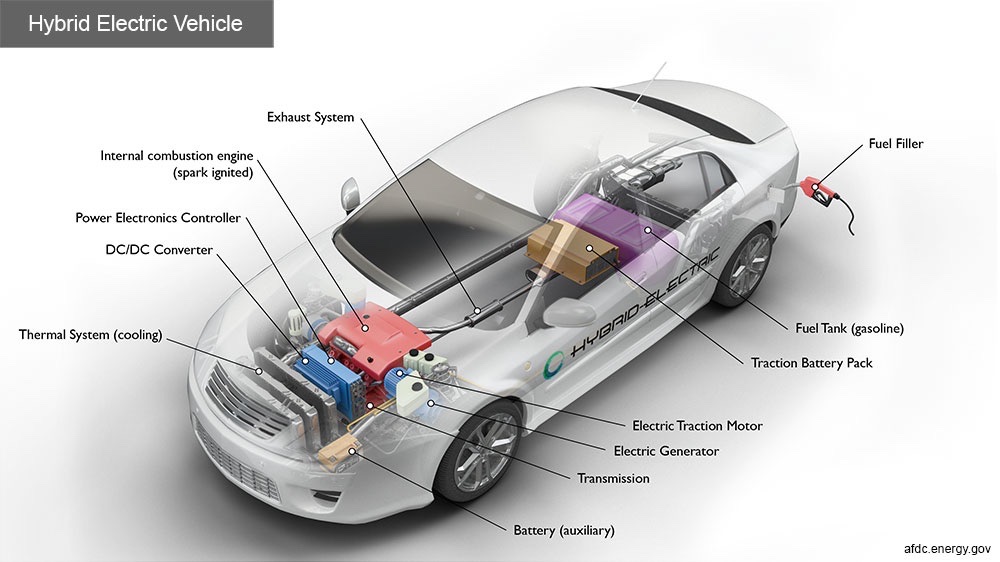
Hybrid electric vehicles (HEVs) combine an internal combustion engine (ICE) with one or more electric motors powered by batteries. Unlike plug-in hybrids, HEVs cannot be plugged in to charge their batteries. Instead, the battery is charged through regenerative braking and by the ICE. The electric motor provides additional power to the vehicle, which can allow for a smaller and more efficient engine, improve fuel economy, and reduce emissions without compromising performance.
Key Components of a Hybrid Electric Car
- Battery (Auxiliary):
- Provides electricity to start the car before the traction battery is engaged and powers vehicle accessories.
- DC/DC Converter:
- Converts higher-voltage DC power from the traction battery pack to the lower-voltage DC power needed to run vehicle accessories and recharge the auxiliary battery.
- Electric Generator:
- Generates electricity from the rotating wheels while braking, transferring that energy back to the traction battery pack. Some vehicles use motor generators that perform both drive and regeneration functions.
- Electric Traction Motor:
- Drives the vehicle’s wheels using power from the traction battery pack. Some vehicles use motor generators that perform both drive and regeneration functions.
- Exhaust System:
- Channels exhaust gases from the engine out through the tailpipe. A three-way catalyst reduces engine-out emissions within the exhaust system.
- Fuel Filler:
- A nozzle from a fuel dispenser attaches to the vehicle’s receptacle to fill the tank with gasoline.
- Fuel Tank (Gasoline):
- Stores gasoline on board the vehicle until needed by the engine.
- Internal Combustion Engine (Spark-Ignited):
- In this configuration, fuel is injected into either the intake manifold or the combustion chamber, where it is combined with air. The air/fuel mixture is ignited by a spark from a spark plug.
- Power Electronics Controller:
- Manages the flow of electrical energy delivered by the traction battery, controlling the speed of the electric traction motor and the torque it produces.
- Thermal System (Cooling):
- Maintains a proper operating temperature range for the engine, electric motor, power electronics, and other components.
- Traction Battery Pack:
- Stores electricity for use by the electric traction motor.
- Transmission:
- Transfers mechanical power from the engine and/or electric traction motor to drive the wheels.
How Hybrid Electric Cars Enhance Efficiency
- Regenerative Braking:
- Converts kinetic energy from braking into electrical energy, which is stored in the traction battery pack.
- Idle Reduction:
- Shuts off the ICE when the vehicle is stopped, reducing fuel consumption and emissions.
- Power Assist and Smaller Engine:
- Uses the electric motor to assist the ICE during acceleration, allowing for a smaller and more efficient engine.
- Electric-Only Drive:
- Some hybrids can operate on electric power alone at low speeds and for short distances, reducing fuel consumption.
Advantages of Hybrid Electric Cars
- Improved Fuel Efficiency:
- Combining electric and gasoline power results in better fuel economy compared to traditional ICE vehicles.
- Reduced Emissions:
- Lower tailpipe emissions due to reduced reliance on the ICE.
- Enhanced Performance:
- Instant torque from the electric motor can improve acceleration.
Hybrid electric vehicles provide a balanced approach to reducing fuel consumption and emissions while maintaining the convenience of a gasoline engine, making them an attractive option for many drivers.
